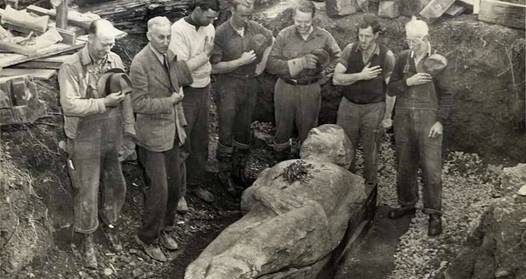Executive editor of Archaeology, Mark Rose, wrote When Giants Roamed the Earth for that journal’s Volume 58 Number 6, November/December 2005.
It’s noted:
Mark Twain parodied petrifaction hoaxes with his account of the discovery of one, which some newspapers took as a true story. He also aimed his humor at the Cardiff Giant.
Gideon Emmons and Henry Nichols are nowhere listed among the heroes of American archaeology, but the discovery they made on October 16, 1869, captured the nation’s imagination. Digging a well on the farm of William “Stub” Newell in the hamlet of Cardiff, New York, they hit stone three feet down. Clearing the soil, they recognized the shape of a foot, and one of them uttered the immortal words, “I declare, some old Indian has been buried here!”
Soon they had unearthed a colossal stone figure more than 10 feet from head to toe. What Emmons and Nichols didn’t know was the stone man was the creation of Binghamton cigar maker George Hull, who was Newell’s cousin, and that Hull and Newell had planted it there nearly a year before. Hundreds of people flocked to see the marvel. Newell set up a tent over it and started charging 25c a head. Business was so brisk that he increased it to 50c two days later.

Andrew White, first president of Cornell University (and hoaxer promulgator of the myth that a significant number of people through human history believed that the Earth is flat) allegedly
…overheard “a very excellent doctor of divinity, pastor of one of the largest churches in Syracuse” declare that, “Is it not strange that any human being, after seeing this wonderfully preserved figure, can deny the evidence of his senses, and refuse to believe, what is so evidently the fact, that we have here a fossilized human being, perhaps one of the giants mentioned in Scripture?”
It seems that, if any such thing was ever actually stated, the pastor had not idea of what he spake since:
What is, “of the giants mentioned in Scripture?” We can’t know until that pastor answered: what’s the usage of the vague, generic, subjective, multi-usage and modern English word “giants” in English Bibles? What’s your usage? Do those two usages agree?
Well, his usage clearly seems to have been something about un-specifically generically vague about subjectively unusual height.
Yet, in the English Bible that employ that term, it merely renders (doesn’t even translate) “Nephilim” in 2 verses or “Repha/im” in 98% of all others and so never even hints at anything to do with any sort of height whatsoever.
And, the tallest person in the Bible was an Egyptian who was 7.5ft. (2 Sam 23).
Mark Rose also wrote:
Evidence of giants in America was nothing new. The Massachusetts Puritan Cotton Mather believed that mastodon fossils found near Albany, New York, in 1705 were those of giants who had perished in Noah’s flood.
“The Giants that once groaned under the waters,” he wrote, “are now under the Earth, and their Dead Bones are lively Proofs of the Mosaic history.”
He got the under water part from Job 26:5 which the ESV, for example, has as, “The dead tremble under the waters and their inhabitants” so there’s nothing about giants in that text: it’s just that the root rapha/im is used there and, as we saw above, some English Bibles render Repha/im as giant(s). Thus, none of that had to do with, “Proofs of the Mosaic history.”
Moreover:
Thomas Jefferson had his own interest in fossils, and in 1804 he even set aside a room in the White House for his collection of extinct elephant, giant ground sloth, and bison bones, teeth, and tusks.
Earlier, he had convinced Yale College president Ezra Stiles that such remains were of animals rather than giants. Fascinated by an immense claw of a ground sloth, Jefferson wrote to a friend, “I cannot…help believing that this animal, as well as the mammoth, are still existing.”
This is fascinating in that at least from the time of Flavius Josephus writing that bones of Rephaim were on display, it’s been unknown if, say, a historian such as he were qualified anatomists who could distinguish between human/oid bones and the bones of pachyderm, whales, dinos, sloths, bison, etc., etc., etc.
See appendix, “Review of Adrienne Mayor’s The First Fossil Hunter” in my book What Does the Bible Say About Giants and Nephilim? A Styled Giantology and Nephilology.
Also, see chapter, “Giant Skeletons Reported in Old Newspapers Accounts” in my book Nephilim and Giants: Believe It or Not!: Ancient and Neo-Theo-Sci-Fi Tall Tales since giants obsessed people seem to think that if it was printed in a newspaper then, by golly, it must be true—and infallibly so.
It’s also noted that, “Josiah Priest, writing in his American Antiquities and Discoveries in the West…cites Scripture on giants” who knows what those were, “and notes, ‘There are those who imagine that the first inhabitants of the globe, or the antediluvians, were much larger than our race at the present time.’”
One giant he mentions is Nimrod: for whom we’ve no physical description. Yet, Priest argues, “The Septuagint version of the Scriptures speaks of Nimrod as being a surly giant” since that version, the LXX, renders what’s, “And Cush begat Nimrod: he began to be a mighty one in the earth” in the KJV, as that Nimrod began to be a γίγας.
Yet, the issue is that the LXX renders Nephilim and also Repha/im and also gibbor/im all as gigas (γίγας) or gigantes (γίγαντες) both of which are in reference to the false Greek goddess Gaia—with the latter word referring to earth-born. Thus, γίγας implies nothing about size: that was just a word-concept fallacy.
Another giant Priest mentioned was Goliath yet, the Masoretic text has him at just shy of 10 ft. Yet, the earlier LXX and the earlier Dead Sea Scrolls and the earlier Flavius Josephus all have him at just shy of 7 ft. (compared to the average Israelite male who was 5.0-5.3 ft. in those days) so that’s the preponderance of the earliest data.
Perhaps that was the case yet, the dirty little secret is that since we’ve no reliable physical description of Nephilim then their height is a non-issue and that alone debunks 99% of un-biblical Nephilology—the modern branch of which is just un-biblical neo-theo sci-fi tall-tales.
And, the rest of those inhabitants don’t show signs of having been taller than the modern average—and were actually shorter.
Reportedly:
In 1866, [George] Hull…an atheist, got into a heated argument with Rev. Mr. Turk, a Methodist revivalist. Hull later recalled spending the night “wondering about why people would believe those remarkable stories in the Bible about giants, when suddenly I thought of making a stone giant, and passing it off as a petrified man.”
Pray tell, what, “remarkable stories in the Bible about giants” were those?
~~~~~~~~~~~~~~~~~~~~~~~
A plea: I have to pay for server usage and have made all content on this website free and always will. I support my family on one income and do research, writing, videos, etc. as a hobby.
If you can even spare $1.00 as a donation, please do so: it may not seem like much but if each person reading this would do so, even every now and then, it would add up and really, really help out.
Here is my donate/paypal page.
You can comment here and/or on my Twitter/X page, on my Facebook page, or any of my other social network sites all which are available here.
